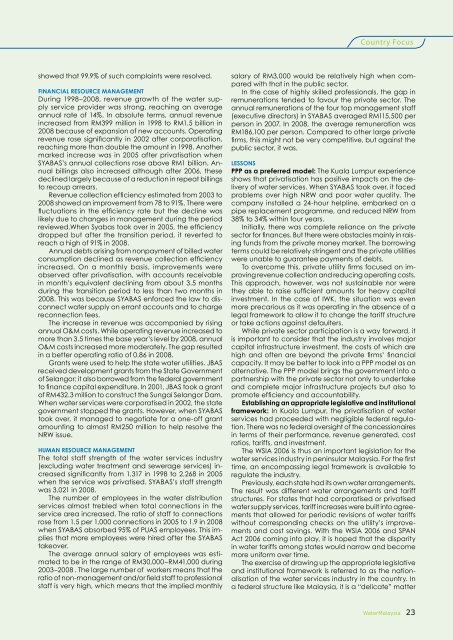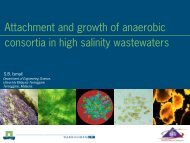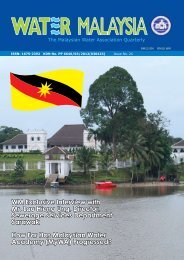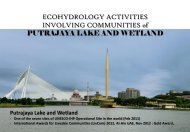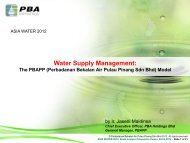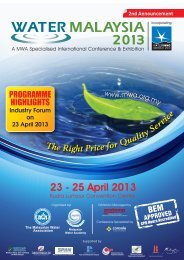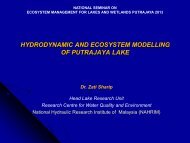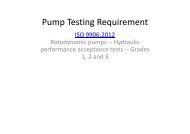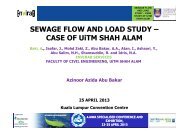Returning Malaysia's Rivers To L - Malaysian Water Association.
Returning Malaysia's Rivers To L - Malaysian Water Association.
Returning Malaysia's Rivers To L - Malaysian Water Association.
You also want an ePaper? Increase the reach of your titles
YUMPU automatically turns print PDFs into web optimized ePapers that Google loves.
Country Focus<br />
showed that 99.9% of such complaints were resolved.<br />
Financial Resource Management<br />
During 1998–2008, revenue growth of the water supply<br />
service provider was strong, reaching an average<br />
annual rate of 14%. In absolute terms, annual revenue<br />
increased from RM399 million in 1998 to RM1.5 billion in<br />
2008 because of expansion of new accounts. Operating<br />
revenue rose significantly in 2002 after corporatisation,<br />
reaching more than double the amount in 1998. Another<br />
marked increase was in 2005 after privatisation when<br />
SYABAS’s annual collections rose above RM1 billion. Annual<br />
billings also increased although after 2006, these<br />
declined largely because of a reduction in repeat billings<br />
to recoup arrears.<br />
Revenue collection efficiency estimated from 2003 to<br />
2008 showed an improvement from 78 to 91%. There were<br />
fluctuations in the efficiency rate but the decline was<br />
likely due to changes in management during the period<br />
reviewed.When Syabas took over in 2005, the efficiency<br />
dropped but after the transition period, it reverted to<br />
reach a high of 91% in 2008.<br />
Annual debts arising from nonpayment of billed water<br />
consumption declined as revenue collection efficiency<br />
increased. On a monthly basis, improvements were<br />
observed after privatisation, with accounts receivable<br />
in month’s equivalent declining from about 3.5 months<br />
during the transition period to less than two months in<br />
2008. This was because SYABAS enforced the law to disconnect<br />
water supply on errant accounts and to charge<br />
reconnection fees.<br />
The increase in revenue was accompanied by rising<br />
annual O&M costs. While operating revenue increased to<br />
more than 3.5 times the base year’s level by 2008, annual<br />
O&M costs increased more moderately. The gap resulted<br />
in a better operating ratio of 0.86 in 2008.<br />
Grants were used to help the state water utilities. JBAS<br />
received development grants from the State Government<br />
of Selangor; it also borrowed from the federal government<br />
to finance capital expenditure. In 2001, JBAS took a grant<br />
of RM432.3 million to construct the Sungai Selangor Dam.<br />
When water services were corporatised in 2002, the state<br />
government stopped the grants. However, when SYABAS<br />
took over, it managed to negotiate for a one-off grant<br />
amounting to almost RM250 million to help resolve the<br />
NRW issue.<br />
Human Resource Management<br />
The total staff strength of the water services industry<br />
(excluding water treatment and sewerage services) increased<br />
significantly from 1,317 in 1998 to 2,268 in 2005<br />
when the service was privatised. SYABAS’s staff strength<br />
was 3,021 in 2008.<br />
The number of employees in the water distribution<br />
services almost trebled when total connections in the<br />
service area increased. The ratio of staff to connections<br />
rose from 1.5 per 1,000 connections in 2005 to 1.9 in 2008<br />
when SYABAS absorbed 95% of PUAS employees. This implies<br />
that more employees were hired after the SYABAS<br />
takeover.<br />
The average annual salary of employees was estimated<br />
to be in the range of RM30,000–RM41,000 during<br />
2003–2008 . The large number of workers means that the<br />
ratio of non-management and/or field staff to professional<br />
staff is very high, which means that the implied monthly<br />
salary of RM3,000 would be relatively high when compared<br />
with that in the public sector.<br />
In the case of highly skilled professionals, the gap in<br />
remunerations tended to favour the private sector. The<br />
annual remunerations of the four top management staff<br />
(executive directors) in SYABAS averaged RM115,500 per<br />
person in 2007. In 2008, the average remuneration was<br />
RM186,100 per person. Compared to other large private<br />
firms, this might not be very competitive, but against the<br />
public sector, it was.<br />
Lessons<br />
PPP as a preferred model: The Kuala Lumpur experience<br />
shows that privatisation has positive impacts on the delivery<br />
of water services. When SYABAS took over, it faced<br />
problems over high NRW and poor water quality. The<br />
company installed a 24-hour helpline, embarked on a<br />
pipe replacement programme, and reduced NRW from<br />
38% to 34% within four years.<br />
Initially, there was complete reliance on the private<br />
sector for finances. But there were obstacles mainly in raising<br />
funds from the private money market. The borrowing<br />
terms could be relatively stringent and the private utilities<br />
were unable to guarantee payments of debts.<br />
<strong>To</strong> overcome this, private utility firms focused on improving<br />
revenue collection and reducing operating costs.<br />
This approach, however, was not sustainable nor were<br />
they able to raise sufficient amounts for heavy capital<br />
investment. In the case of IWK, the situation was even<br />
more precarious as it was operating in the absence of a<br />
legal framework to allow it to change the tariff structure<br />
or take actions against defaulters.<br />
While private sector participation is a way forward, it<br />
is important to consider that the industry involves major<br />
capital infrastructure investment, the costs of which are<br />
high and often are beyond the private firms’ financial<br />
capacity. It may be better to look into a PPP model as an<br />
alternative. The PPP model brings the government into a<br />
partnership with the private sector not only to undertake<br />
and complete major infrastructure projects but also to<br />
promote efficiency and accountability.<br />
Establishing an appropriate legislative and institutional<br />
framework: In Kuala Lumpur, the privatisation of water<br />
services had proceeded with negligible federal regulation.<br />
There was no federal oversight of the concessionaires<br />
in terms of their performance, revenue generated, cost<br />
ratios, tariffs, and investment.<br />
The WSIA 2006 is thus an important legislation for the<br />
water services industry in peninsular Malaysia. For the first<br />
time, an encompassing legal framework is available to<br />
regulate the industry.<br />
Previously, each state had its own water arrangements.<br />
The result was different water arrangements and tariff<br />
structures. For states that had corporatised or privatised<br />
water supply services, tariff increases were built into agreements<br />
that allowed for periodic revisions of water tariffs<br />
without corresponding checks on the utility’s improvements<br />
and cost savings. With the WSIA 2006 and SPAN<br />
Act 2006 coming into play, it is hoped that the disparity<br />
in water tariffs among states would narrow and become<br />
more uniform over time.<br />
The exercise of drawing up the appropriate legislative<br />
and institutional framework is referred to as the nationalisation<br />
of the water services industry in the country. In<br />
a federal structure like Malaysia, it is a “delicate” matter<br />
<strong>Water</strong>Malaysia 23


